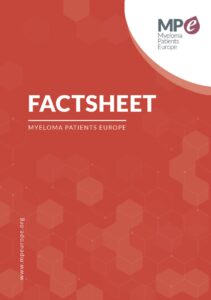What is ciltacabtagene autoleucel, cilta-cel (Carvykti®)?
Ciltacabtagene autoleucel (also known as cilta-cel or Carvykti®) is a chimeric antigen receptor T-cell therapy (CAR T-cell therapy). Cilta-cel was granted “orphan drug” designation by the European Commission in 2020. An orphan drug designation is a status assigned to medicines developed for rare disease conditions that affect fewer than five patients per 10,000 inhabitants in the EU. The EMA authorised cilta-cel in May 2022 for treating adults with multiple myeloma whose cancer has returned (relapsed) or has not responded to treatment (refractory). Cilta-cel is used when patients’ disease worsens despite receiving at least three prior therapies, including an immunomodulatory agent, a proteasome inhibitor and an anti-CD38 antibody1.
How does ciltacabtagene autoleucel work?
Cilta-cel is a type of immunotherapy that uses a patient’s white blood cells, specifically T cells, extracted through a blood draw. The T cells are then sent to a laboratory for manufacturing and genetic modification to include a protein molecule called a “chimeric antigen receptor” (CAR). The CAR protein sits on the surface of T cells to help find myeloma cells and kill them. Once the manufactured T cells are multiplied and reinfused into the patient’s body, they find and bind to cancerous myeloma cells via the B cell maturation antigen (BCMA) protein often found on the surface of the myeloma cell. After binding, the T cells release cytokines to kill the myeloma cell and recruit the immune system.
What are the benefits of ciltacabtagene autoleucel?
The safety and efficacy of cilta-cel were evaluated in the CARTITUDE-1 phase 1b/2 study in 113 patients with relapsed/refractory multiple myeloma, 97 of whom received cilta-cel. This study found that 98% of patients responded to treatment with cilta-cel, with a response lasting around 21.8 months2,3. A total of 61 patients who participated in the trial were measured for minimal disease negativity (also known as MRD; a test result that means no myeloma cells are detected in 100 thousand or even one million cells). In the CARTITUDE-1 trial, 91.8% of patients were MRD negative after treatment.2 Other clinical studies are ongoing to assess efficacy and safety of cilta-cel in broader populations of myeloma patients. For example, the CARTITUDE-2 study evaluated the efficacy and safety of cilta-cel in patients with multiple myeloma and early relapse after initial treatment. Of the 18 patients who received cilta-cel, the overall response rate was 88.9%4. Of the nine evaluated patients, 100% were MRD-negative after treatment.
How is ciltacabtagene autoleucel given to patients?
First, you will undergo leukapheresis or white blood cell (T cell) extraction through a blood draw. These cells will be used to prepare the CAR T-cells. The manufacturing time for cilta-cel may take 4-6 weeks, during which time you might receive a bridging therapy (a combination treatment of standard myeloma drugs given to prevent disease progression before CAR T-cell infusion). Before receiving cilta-cel, you will receive conditioning chemotherapy (also known as lymphodepletion therapy) to reduce your level of white blood cells and help your body accept the CAR T-cell therapy. When the CAR T-cells are ready, they are given through an infusion into a vein. Because of the potential side effects, infusions are administered in a certified healthcare facility where you can be monitored closely for at least seven days. After this, you will be instructed to stay within close proximity of a healthcare facility, or hospital, for four weeks for any potential side effects to be promptly managed. Conditioning treatment and CAR T-cell therapy may increase your risk of infection, therefore you may be advised to take precautions to prevent infection such as handwashing, wearing a mask and avoiding large crowds. Your provider may also recommend that you be up to date on vaccinations before treatment.
What are the side effects of ciltacabtagene autoleucel?
The safety of cilta-cel was evaluated in the CARTITUDE-1 study of 97 patients. The most common other side effects of cilta-cel (occurring in more than 20% of patients, listed from most common to least common) included1,5:
- Fever (pyrexia)
- Cytokine release syndrome (CRS; a potentially life-threatening systemic inflammatory condition)
- Hypotension (low blood pressure)
- Pain in the muscles and bones
- Fatigue
- Infections
- Cough
- Chills
- Gastrointestinal symptoms (e.g., diarrhoea, nausea, decreased appetite)
- Encephalopathy (confusion)
- Upper respiratory tract infections
- Headache
- Tachycardia (a faster than normal heartrate)
- Dizziness
- Shortness of breath (dyspnoea)
- Fluid retention (oedema)
- Viral infections
- Changes in blood electrolyte levels such as calcium, potassium and phosphate can also occur, although these are less common.
In addition to the above side effects, changes in blood levels were among the most common, including the following, which occurred in greater than 10% of patients: and life-threatening side effects in some patients. The most common, serious side effects observed include:
- Cytokine release syndrome (CRS) (a mild to life-threatening systemic inflammatory response experienced due to the release of cytokines from CAR T-cells)
- Thrombocytopenia (low levels of platelets)
- Febrile neutropenia (low levels of a type of white blood cell known as neutrophils along with a fever)
- Sepsis (an infection in the bloodstream)
- Immune effector cell-associated neurotoxicity syndrome (ICANS)1 Of note, there were 21 deaths during the study, six that were considered treatment-related2.
Side effects of CAR T-cell therapy often occur during or shortly after treatment, however some side effects may have a delayed onset, or may last longer. While some side effects may be managed with observation and supportive care, others require specific treatments (e.g., CRS is treated with steroids or a monoclonal antibody called tocilizumab). For more detailed information on the side effects related to CAR T-cell therapy, including when during treatment they usually occur, and how they are manage, please, explore our educational resources on CAR-T therapy.
